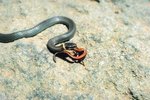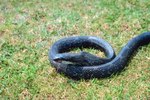Maryland is home to 27 different species of snakes, 22 of which can be found on the state's Eastern Shore, east of the Chesapeake Bay.
Common Snakes
Ten species occur throughout Maryland, including the state's Eastern Shore. These include the black rat snake, eastern garter snake, eastern hognose snake, eastern ribbon snake, eastern worm snake, northern black racer, northern brown snake, northern and southern ringneck snakes and northern water snake.
Regional Snakes
Some snakes are restricted to certain regions within Maryland. The eastern kingsnake and rough green snake are native to only the eastern portions of the state. The eastern milk snake, present throughout northern Maryland, is restricted to Cecil County on the Eastern Shore.
Rare Snakes
Of the state's harder-to-find snakes are five native to the Eastern Shore. The corn snake can be found in mid-regions of the shore, from Talbot to Somerset counties. The northern redbelly snake and the smooth earth snake like the damp, heavy cover of the southeastern part of the state. Within the Eastern Shore, the northern scarlet snake can only be found in Wicomico and the queen snake in Cecil and Kent counties.
Species of Concern
The redbelly water snake--found only in Dorchester, Somerset, Wicomico, Worcester counties--is on the state's species of concern list. The Eastern Shore of Maryland is the northern extent of this snake, which likes low, wet areas.
Poisonous Snakes
Copperhead snakes--specifically northern copperheads and, to a lesser extent, southern copperheads--are the only poisonous species of snake that can be found on the Eastern Shore of Maryland.
Historic Species
The northern pine snake is considered a historic species to Maryland, specifically to Worchester County on the Eastern Shore, because no existing populations can be verified.
References
Photo Credits
-
Slithery Snake image by J3TPhotos from Fotolia.com
Writer Bio
Juliana Torres started writing in 2004 for "The Daily Texan." She was an intern at "People en Español" and "Texas Monthly" and co-authored the book, "A Legacy Greater Than Words." While writing for the "Osceola News-Gazette," she won several Florida Press Association awards. Torres earned a Bachelor of Journalism and a Bachelor of Arts in Spanish from the University of Texas-Austin.




